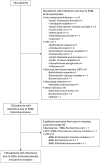Effectiveness of temocillin in treatment of non-urinary tract infections caused by ESBL-producing Enterobacterales and risk factors for failure
- PMID: 39421154
- PMCID: PMC11483619
- DOI: 10.1093/jacamr/dlae164
Effectiveness of temocillin in treatment of non-urinary tract infections caused by ESBL-producing Enterobacterales and risk factors for failure
Abstract
Objectives: To describe the real-life use of temocillin for non-urinary tract infections, to assess its effectiveness in infections caused by ESBL-producing Enterobacterales, and to identify risk factors for treatment failure.
Method: Retrospective multicentric study in 14 tertiary care hospitals, including all patients who received at least one dose of temocillin for ESBL infections from 1 January 2016 to 31 December 2021 for non-urinary tract infections. Failure was a composite criterion defined within 28 day follow-up by persistence or reappearance of signs of infection, and/or switch to suppressive antibiotic treatment and/or death from infection. Logistic regression with univariable and multivariable analysis was performed to identify risks associated with failure.
Results: Data on 163 infection episodes were collected; 133 were due to ESBL-producing Enterobacterales and 128 were included in the effectiveness analysis. Median (IQR) age was 61 (53-70) years and 61.7% of patients were male. Main indications were lower respiratory tract infection (LRTI; 28.9%), intra-abdominal infections (IAI; 28.1%) and cutaneous infections (12.5%). The main bacteria involved were Klebsiella pneumoniae (48.4%), Escherichia coli (25.0%) and Enterobacter cloacae (24.2%). Polymicrobial infections occurred in 45.3% of cases. Temocillin was used as monotherapy in 86/128 (67.2%). Failure was found in 36/128 (28.1%) cases. In multivariable analysis, the only factor associated with failure was initial severity of the episode [adjusted OR 3.0 (95% CI: 1.06-8.69)].
Conclusions: During non-urinary tract infections, the main use of temocillin was for LRTIs and IAIs due to ESBL-producing E. coli and K. pneumoniae. The main risk factor for failure was initial severity of the disease.
© The Author(s) 2024. Published by Oxford University Press on behalf of British Society for Antimicrobial Chemotherapy.
References
-
- Cassini A, Högberg LD, Plachouras D et al. Attributable deaths and disability-adjusted life-years caused by infections with antibiotic-resistant bacteria in the EU and the European Economic Area in 2015: a population-level modelling analysis. Lancet Infect Dis 2019; 19: 56–66. 10.1016/S1473-3099(18)30605-4 - DOI - PMC - PubMed
-
- ECDC . Assessing the health burden of infections with antibiotic-resistant bacteria in the EU/EEA, 2016-2020. 2022. https://www.ecdc.europa.eu/en/publications-data/health-burden-infections....
LinkOut - more resources
Full Text Sources

